Choosing the Right Material for Pet Door Flaps

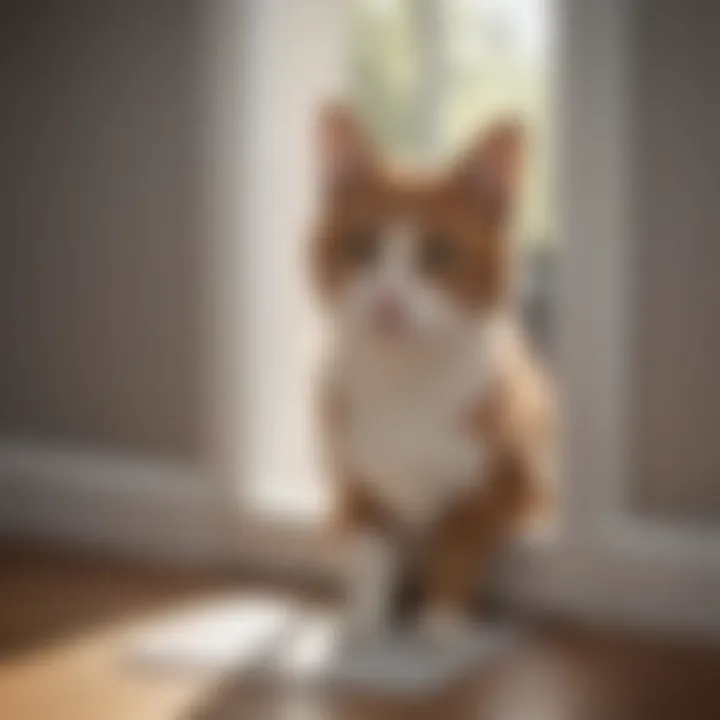
Intro
When it comes to our furry friends, pet owners want to provide the best home possible. A pet door flap may seem like a small addition to your household, but it plays a big role in the comfort and autonomy of your pets. Just like we consider materials for furniture or flooring, understanding the right materials for pet door flaps is crucial. Not all flaps are created equal; some materials can withstand the elements better, while others provide better insulation or security. In this comprehensive guide, we will explore various materials available for pet door flaps—from durable plastics to sturdy metals, and even warm woods.
Choosing the right material involves considering factors such as durability, insulation, and maintenance. Each option has its own strengths and weaknesses, calling for careful evaluation based on your specific needs. Additionally, pet owners must think about safety and the overall compatibility of the flap with their home and pet's behavior. This article seeks to empower pet lovers with knowledge, allowing you to make informed decisions that enhance both your living environment and your pets' lives.
Pet Door Flap Materials
Plastic Flaps
Plastic flaps are a popular choice among pet owners. They are lightweight and often come in various colors and styles, allowing them to blend smoothly with home decor. Made from polycarbonate or other similar materials, plastic can be less expensive compared to its metal counterparts while still offering decent durability. However, over time, exposure to harsh weather can cause them to become brittle and yellow, so placing these in a shaded area or under an awning can prolong their life.
Metal Flaps
Metal flaps, such as those made from aluminum or stainless steel, are the heavyweights of pet door options. Known for robust construction, they stand up well to wear and tear, ensuring that they withstand even the most enthusiastic pets. An added advantage is that metal often comes with reinforced security features, making it a reliable option if you live in a high-traffic area or want to ensure your home stays secure.
The downside? Metal can be pricier than plastic and may require more maintenance in terms of protecting against rust, especially if placed outdoors in wet climates.
Vinyl Flaps
Vinyl is another contender in the pet door world. Its flexibility provides a snug fit while also allowing for easy access. It's also quite resistant to scratching and can handle the occasional bump from a large breed dog. What makes vinyl stand out is its excellent insulation properties—keeping the cold out during winter months. The downside can be its susceptibility to UV damage if exposed for long periods without protection.
Wooden Flaps
For those who prioritize aesthetics, wooden flaps might be the way to go. Offering warmth and a natural feel, they can complement traditional homes beautifully. However, opting for wood requires consideration of maintenance as it may warp or rot when exposed to moisture over time. Proper sealing can mitigate these issues, but it’s essential to keep an eye on its condition to ensure longevity.
Making the Right Choice
In navigating the sea of options, consider the climate and environment surrounding your home. For instance, in a colder climate, a more insulated flap will be beneficial. Conversely, if aesthetics is key for your home, you might lean towards wooden or well-designed metal flaps.
"Choosing a pet door flap is more than just a purchase; it’s about understanding how it fits within your lifestyle and your pet's needs."
Also, always take into account your pet's habits. Energetic pets might benefit from more durable materials, while older or calmer pets may suit lighter options fine.
Closure
Understanding the materials available for pet door flaps helps to pave the way for a suitable selection for both you and your pet. From the practicality of plastic and metal to the aesthetic charm of wood, making an informed decision can enrich your pet’s life and enhance your home. Whether it’s a landscape of plastic flaps or an elegant wooden door, choosing right sets the stage for a convenient and happy environment.
Preface to Pet Door Flaps
Pet door flaps are more than just panels that swing open; they represent a gateway to freedom and convenience for our beloved pets. Since many pet owners juggles busy schedules, having a reliable access point for their furry companions to enter and exit is a game-changer. They not only encourage independent behavior in animals but also enhance the overall quality of life for both the pet and owner. Nobody wants to be the doorbell for their cat or dog every time nature calls.
Understanding the crucial elements concerning pet door flaps—such as the different materials available, their various properties, and how these factors align with your pet's needs—becomes paramount. The right choice can have lasting benefits, from how well it insulates your home to its durability against the playful antics of your pets.
Definition and Purpose
A pet door flap can be simply defined as a small, hinged door that allows pets to pass through walls or doors freely. While the concept sounds straightforward, these flaps come in various styles, fits, and functionalities, accommodating everything from small dogs to the most agile of cats. The primary purpose of a pet door flap is to enable pets to explore outdoors, socialize, or fulfill their bathroom needs autonomously, thus freeing owners from the constant monitoring of their pets' natural instincts. This facilitates a healthier lifestyle for pets, as they can engage with their environment freely.
Historical Overview
The origin of pet doors is largely obscure, but their presence can be traced back to ancient times. Even in early human history, animals had their designated entries in living spaces. For instance, in traditional farming communities, small openings were often designated for dogs or cats to come and go, ensuring they could assist with pest control or protection duties while maintaining independence from their human counterparts. As households evolved, so did the design and functionality of pet doors. In the 20th century, the introduction of modern materials led to more durable and efficient options—making it easier than ever for pet owners to set up a door flap that fit their homes' aesthetics and functional requirements.
Today, pet door flaps continue to evolve with advancements in technology and materials ranging from plastic to high-grade metals. Each material offers its own set of pros and cons, making careful selection crucial. Choosing the right kind can not only save money and time in the long run but also create a safe environment for your pet.
Material Types for Pet Door Flaps
When it comes to pet door flaps, the choice of material plays a pivotal role in ensuring that your furry friend enjoys seamless access while maintaining the integrity and comfort of your home. Not all pet door flaps are created equal; they vary in functionality, weather resistance, and durability, which can significantly impact both your pet’s experience and your own comfort as a homeowner. Understanding the distinct properties of different materials allows pet owners to make well-informed decisions tailored to their specific needs.
Plastic Pet Door Flaps
Plastic pet door flaps are among the most ubiquitous options available on the market. Their lightweight nature makes them easy to install, and they're often budget-friendly. This makes them a popular choice, especially for those who may be new to the pet ownership game.
However, not all plastics are created equal. Some plastic flaps offer UV resistance, shielding them from potential warping or discoloration that comes with prolonged sun exposure. But, as sturdy as plastic can be, it might not stand up to all the roughhousing from larger pets.
- Pros:
- Cons:
- Affordable
- Lightweight and easy to handle
- UV resistant options available
- Can be less durable than metal or wood
- May be vulnerable to chewing or scratches from more aggressive pets
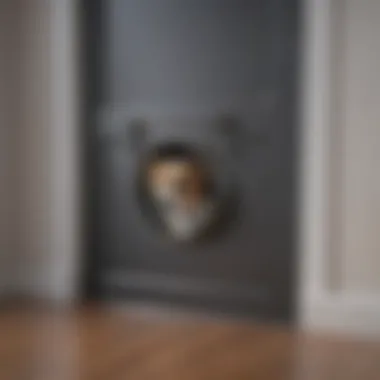
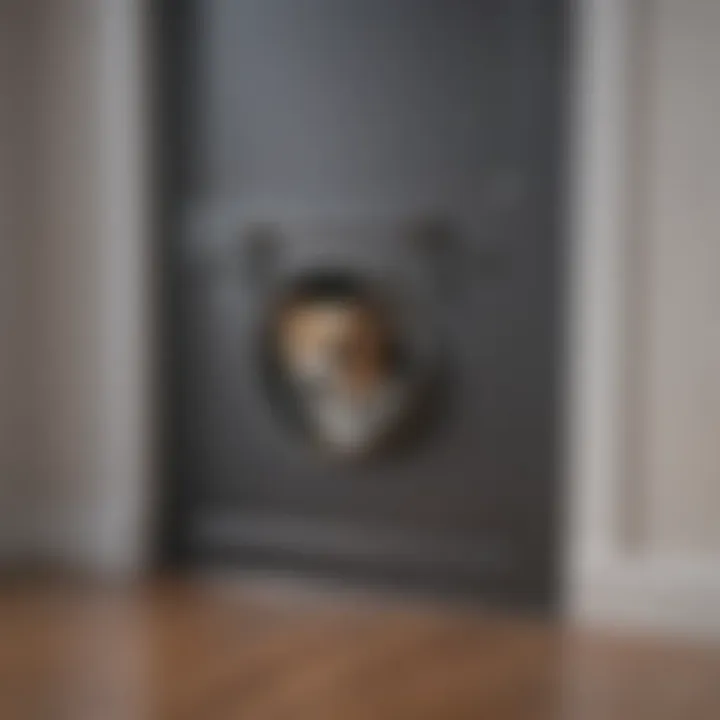
Metal Pet Door Flaps
When you prioritize durability and strength, metal pet door flaps stand out from the pack. Often made from aluminum or stainless steel, these flaps can withstand the test of time and a myriad of weather conditions. Metal options are highly resistant to scratching and can endure even the most boisterous of pets.
While they do have clear advantages regarding durability, metal flaps often come at a steeper price point. Additionally, their heavier weight means they might require a bit of extra effort during installation. Also of note is that they can become quite cold in winter.
- Pros:
- Cons:
- Remarkably durable
- Scratch-resistant surfaces
- Can stand strong against various weather conditions
- Higher initial cost
- Installation might require some tools skills
- Can be chillier during colder weather
Vinyl Pet Door Flaps
Vinyl might not be the first material that springs to mind when considering pet door flaps, but it has its charm and distinct advantages. Vinyl flaps offer a softer touch that can be easier on your pet's nose. They often provide decent insulation, helping to control the indoor climate against the whims of Mother Nature.
One notable feature is their transparent nature, which allows your pet to see through the flap before making a leap of faith. However, owners should be mindful of vinyl's susceptibility to fading and warping due to exposure to extreme temperatures.
- Pros:
- Cons:
- Offers good insulation properties
- Transparent options available for better visibility
- Generally lighter than metal options
- Can fade or warp over time
- May require more frequent replacement than other materials
Wood Pet Door Flaps
Wood pet door flaps bring a sense of aesthetic appeal into the equation, merging functionality with style. Often custom-made, wooden flaps can be stained or painted to match your home’s decor, lending a touch of elegance that plastic or metal options can lack.
While wood can provide excellent insulation due to its natural properties, it does require regular maintenance to prevent problems like rot, warping, or insect damage. The correct treatment or paint can keep wood flaps looking pristine and functioning well for years to come.
- Pros:
- Cons:
- Highly customizable
- Natural insulative properties
- Visually appealing
- Often more expensive due to materials and craftsmanship
- Requires ongoing maintenance
- Vulnerable to weathering if not treated properly
Each material provides distinct benefits and challenges, and the choice ultimately boils down to a mixture of personal preference, budget, and your pet’s specific needs.
Understanding Material Properties
In the realm of pet door flaps, understanding material properties is nothing short of paramount. It influences not just how well the flap operates, but also its ability to withstand the test of time, protect your home from the elements, and provide a safe entry for your furry friends. Choosing the right material ensures that pet owners can cater to their pet's specific needs while also considering the home's environment. Ultimately, this knowledge can save time, money, and prevent any future headaches.
Durability and Longevity
When selecting a pet door flap, durability shines as a key characteristic. Different materials respond variably to wear and tear; it's not uncommon for pet doors made from lower-quality plastic to show signs of fatigue after a few months of use. This typically manifests as cracks, warping, or even fading. On the contrary, metal flaps often emerge as champions in this area. They’re hard-wearing and can brave harsh conditions without losing their charm.
For instance, stainless steel flaps resist corrosion, making them ideal for homes in coastal areas where salty air can quickly erode other materials. Pet owners should tread carefully; considering the average lifespan of different materials can lead to smarter investments. A little research on your pet's activites—like if they’re a rambunctious young Labrador—can provide vital insight into choosing a material that will last.
Insulation and Weather Resistance
Insulation properties may not be the first thing on a pet owner’s mind when choosing a pet door, but the impact is huge, especially in regions grappling with extreme temperatures. Imagine a wintery night when snow piles up outside; an uninsulated flap can turn your cozy home into a frosty cave, and that’s no fun for anyone.
Pet door flaps made of thick vinyl or even certain plastics provide decent insulation but still vary in effectiveness. Look for options with thermal seals; these often come with dual flaps or magnetic closures to prevent drafts. Heavy-duty options ensure your pets won’t drag a chill right into your living room. Besides ensuring comfort for pets, good insulation can save you a buck or two on energy bills, which is a win-win scenario for any homeowner.
Maintenance and Cleaning Requirements
Maintenance and cleaning requirements can not be shoved under the carpet—much like cleaning furry tumbleweeds! Some materials are less forgiving when it comes to upkeep. For example, wood flaps might need periodic varnishing or sealing to fend off moisture, while vinyl may be just a wipe away from sparkling.
Additionally, pet doors attract mud and fur like honey attracts flies. This reality means frequent cleaning is part and parcel of having a pet door. Choosing materials that resist staining or can withstand a good scrubbing is crucial.
Understanding these aspects will allow pet owners to pick options that align with their lifestyle, ensuring the pet door flaps continue to look sharp and function well without requiring intensive labor.
"Investing in the right material isn’t just about aesthetics; it’s about practicality and ease of mind in the long run."
In summary, the properties of the materials used for pet door flaps play a significant role in their overall effectiveness and suitability for your home. Prioritizing durability, insulation capabilities, and maintenance requirements will lead to a more beneficial choice that reinforces a stable home environment for both pets and their humans.
Choosing the Right Material for Your Pet
Selecting the ideal material for a pet door flap is not just a matter of preference—it’s crucial for ensuring the comfort and safety of your furry companions. Each pet has different needs based on their size, activity level, and temperament. By diving deep into their requirements, you can make a choice that aligns with your pet's unique characteristics. Here are some vital elements to consider when choosing the right material:
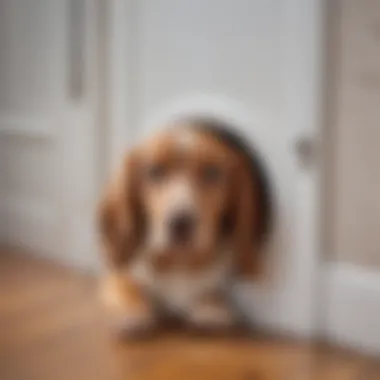
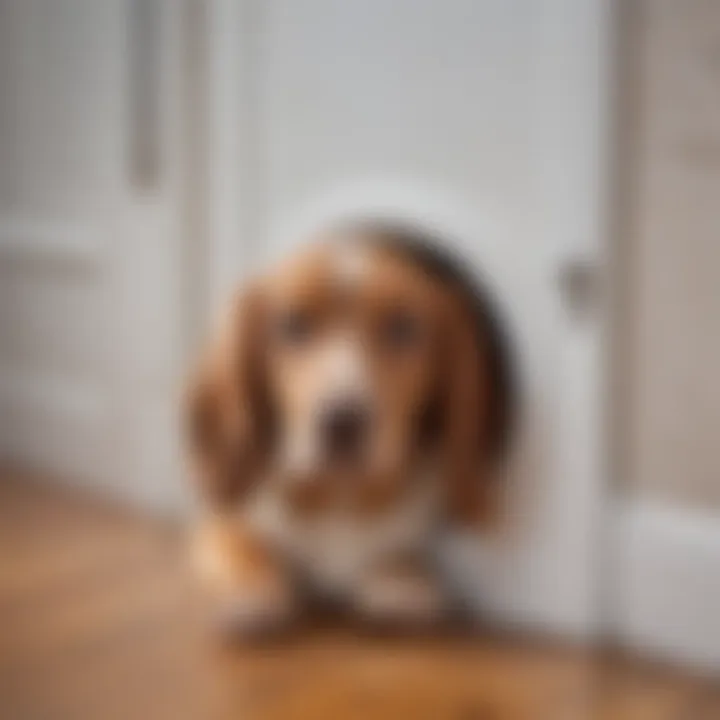
- Durability: Pets can be quite energetic. The flap needs to withstand rough handling. It shouldn't easily come apart after a few enthusiastic pushes.
- Insulation: A well-insulated flap helps maintain a comfortable environment inside your home, which is particularly important in extreme weather.
- Safety: The material must be safe and non-toxic, preventing any potential health issues. Avoid materials that may splinter or degrade, harming your pets in the long run.
This aspect of decision-making can significantly affect how your pet interacts with the door—a poorly made choice can lead to frustrations that both you and your pet want to avoid.
Assessing Your Pet's Needs
Understanding your pet's specific needs requires a close look at their behavior and habits. For instance, larger dogs may benefit from heavier, sturdier materials that can withstand their pushes, while smaller breeds might do just fine with lighter options. A few factors that come into play include:
- Size: Bigger pets can cause more wear and tear on the flap. Consider materials that can handle tougher wear like metal or reinforced plastic.
- Temperament: A skittish pet might need a quieter flap that won’t scare them, so something like soft vinyl could be more suitable.
- Activity Level: If your pet is hyperactive, durability is key. Look for robust materials that don’t warp easily or become damaged with regular use.
When assessing, it’s also helpful to pay attention to past behavior. Has your pet ever hesitated to use a door or been frightened? Taking notes on these quirks can guide your choice substantially.
Considering Home Environment
Your home’s environment plays a pivotal role in which material is suitable for your pet door flap. Different homes have different challenges such as weather, climate conditions, or even decor styles. Here are essential points to ponder:
- Climate: If you live in a place with harsh weather, insulation properties become more significant. Heavy-duty materials such as well-crafted vinyl can aid in keeping drafts at bay.
- Space: Take a look at where you’ll be installing the flap. Is there room for it to swing freely? Depending on the layout, some materials may be more space-efficient than others.
- Aesthetic Considerations: It’s also worth factoring in how the flap looks in relation to your home’s decor. You can find options in various materials that complement your existing design without standing out like a sore thumb.
Ultimately, your pet's comfort and the home environment should guide you to the best decision regarding the material of the pet door flap. Following these guidelines can lead you to a choice that keeps both you and your pet happy, well-protected, and enjoying free access in and out of the house.
"A well-chosen pet door flap is not just a passage; it’s a gateway to comfort and safety. Each decision here impacts their experience, and it’s worth investing the thought."
By considering every angle—your pet’s needs and your home conditions—you can make an informed choice that enhances your living space while accommodating the natural behaviors of your beloved animal.
Cost-Effectiveness of Different Materials
When considering pet door flaps, the angle of cost-effectiveness can't be overstated. Choosing the right material isn't just about the upfront price; it’s about the long-term value it brings, both to your wallet and your pet's experience. Owners must weigh the immediate financial outlay against the durability, maintenance requirements, and how well the flap serves its purpose over time. Each material—be it plastic, metal, vinyl, or wood—has its own financial profile that can significantly influence the overall cost over its lifespan.
Comparative Cost Analysis
To begin with, let's take a closer look at the costs associated with various materials for pet door flaps:
- Plastic: Generally the most affordable option, plastic flaps often come in a range of prices depending on quality. While they may save money initially, their shorter lifespan means more frequent replacements, which can add up.
- Metal: In contrast, metal flaps tend to have a higher initial cost but offer superior durability. They withstand harsh weather better than other materials and require less frequent replacement, making them cost-effective in the long run.
- Vinyl: Vinyl mixes affordability with decent durability. While not as robust as metal, they can offer good insulation and typically need only moderate maintenance, making them a good middle-ground choice.
- Wood: Wood flaps fall into a higher price range. However, their aesthetic appeal and potential for better insulation can justify the cost, especially in a residential setting.
This breakdown is key for potential adopters contemplating their options. It highlights that hastily opting for the cheapest alternative might not yield the best results over time.
Long-Term Investment Considerations
Investing in a pet door flap is often likened to buying a new appliance; you want to think about how much you plan to use it and its effect on your day-to-day life. Here are some factors to keep in mind when evaluating long-term investment:
- Durability: A higher upfront cost for a high-quality flap made of metal or durable vinyl might be wiser. These options usually withstand wear and tear, which means less frequent replacements.
- Energy Efficiency: Some materials, especially those with good insulation properties, can contribute to lower utility bills. Investing in energy-efficient models could translate to significant savings over time.
- Maintenance Costs: Think about the cleaning and upkeep costs associated with your choice. Metal and robust vinyl tend to require less ongoing care than wooden alternatives, where potential rot or warping may emerge.
- Safety Features: A flap that’s designed with safety in mind—like those that are chew-proof or that have secure locking mechanisms—can protect not just your pets but the home itself, preventing costly repairs from security breaches.
It's worth remembering that sometimes, paying a bit more initially can save you a chunk in the long haul.
In a nutshell, before diving into a purchase, take a moment to consider the big picture. What might seem like a few extra dollars today could save you a lot more down the line, ensuring your pet door flap does its job effectively and lasts many years.
Safety Considerations
When it comes to selecting a pet door flap, safety is a top-notch priority. Our furry friends often explore their environment in ways we might not expect, and the last thing any pet owner wants is to endanger their beloved animal. This section dives into critical aspects of safety that you should keep in mind when choosing the right material and design features for your pet door. The goal here is to ensure that the door flap is not just functional, but also secure for your four-legged companions.
Material Toxicity and Pet Safety
The materials used in pet door flaps can vary significantly, and so can their safety profiles. Some plastic types can release harmful chemicals, especially when exposed to varying temperatures or sunlight. It's wise to steer clear of low-quality plastics that may contain phthalates or BPA. If you opt for a wooden flap, ensure it's treated with pet-safe finishes.
For instance, certain paints or sealants might seem harmless to humans but can be toxic to pets. Always look for products labeled as non-toxic and pet-safe. As a pet owner, you might want to check guidelines provided by organizations such as the American Society for the Prevention of Cruelty to Animals (ASPCA) for more detailed insights on materials.
In particular, consider materials such as:
- Polypropylene: A widely accepted plastic that has a good reputation for being durable and non-toxic.
- Metal Flaps: Often less of a concern when it comes to toxicity, but you should still check for sharp edges and rust.
- Natural Wood: A classic choice, just ensure it’s sealed properly with pet-friendly substances.
Taking the time to choose materials carefully can help you avoid unnecessary health risks for your pets.
Design Features for Safety
Beyond material choice, the design elements of a pet door flap play an essential role in ensuring safety. A poorly designed flap could lead to mischief or, worse, injury. Each design should focus on minimizing risks while maximizing ease of use for pets. Here are a few design features that contribute to optimal safety:
- Soft Edges: Sharp edges can be an accident waiting to happen. Opt for flaps that have rounded corners to prevent cuts or scrapes.
- Secure Locking Mechanism: A good locking system not only keeps intruders out but also prevents your pet from exiting the house unattended. Look for a model with multiple security settings.
- Weather Sealing: This ensures that the door closes neatly, reducing the risk of pets getting stuck or caught.
- Visible Transparency: Some flaps come with clear transparent materials that allow pets to see through easily. This can often help cats and dogs feel more secure about using the door, thus preventing accidents.
- Release Feature: If your pet gets too excited and pushes the door too hard, a release mechanism can prevent the flap from jamming or breaking.
A well-designed pet door flap is akin to having a second set of eyes watching over your pet's safety. Investing in quality and thoughtful design ensures peace of mind for every pet parent.
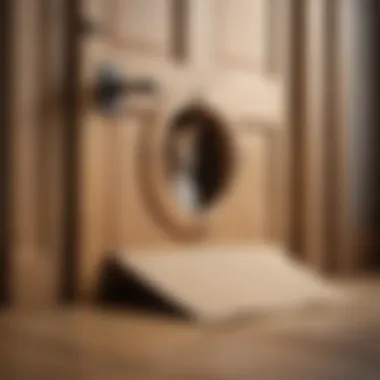
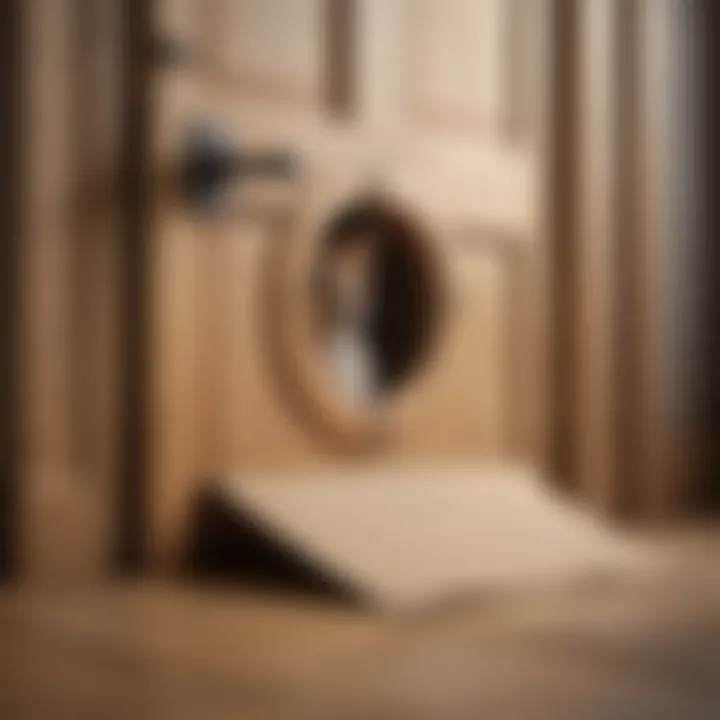
When weighing your options, keep safety front and center. A little forethought can go a long way in creating a pet-friendly environment that keeps your furry friends secure.
Pet Behavior and Material Interaction
When selecting a pet door flap, it's crucial to understand the interplay between your pet's behavior and the materials used in these flaps. This section delves into the preferences and training needs of pets, highlighting how these aspects can affect the choice of materials and the overall functionality of the pet door. A pet's behavior is not merely a byproduct of their surroundings; it's intricately linked to the materials they interact with. By considering these factors, pet owners can create a harmonious environment that caters to both their home and their furry companions.
Material Preference by Pet Type
Different pets have distinct characteristics and temperaments, which can significantly impact their preference for certain door flap materials. For example, cats are often more agile and may prefer flaps that are lighter and easier to push open. A plastic flap might suit them well due to its lightweight nature and flexibility. Conversely, larger dogs might benefit from sturdier materials like metal, which can withstand their weight and strength.
- Smaller pets (like toy dogs and cats) tend to favor plastic or vinyl since they are often easier to manipulate. These materials can also come in various colors and designs, appealing to the playful nature of these pets.
- Medium-sized dogs, on the other hand, may lean toward wood or even upgraded metal versions. These materials often offer durability while catering to the behavioral tendencies of a more energetic pet requiring sturdy structures.
- Lastly, large breeds not only require robust materials but also need a flap with a wider opening to accommodate their size. In such cases, a heavy-duty metal flap could be the best fit, serving both functionality and safety.
Understanding these preferences is essential. If a pet finds the flap too cumbersome or securely fastened, they are likely to resist using it, defeating the purpose of having a pet door. Furthermore, observing a pet's reaction during initial introductions to the flap can provide valuable insights. One must be prepared for pets to exhibit curiosity or apprehension, leading to a trial-and-error phase before they feel comfortable using the door.
Training for Pet Door Use
Training your pet to use a door flap is an essential process that requires patience and understanding. It's not simply a matter of swinging the door open and letting them figure it out; it demands a thoughtful approach that integrates the characteristics of the flap material.
Initially, the training should focus on familiarizing your pet with the door flap. Here are some effective steps:
- Encouragement and Rewards: Start by coaxing your pet to approach the flap. Treats can be a powerful motivator. For instance, placing their favorite snack just beyond the flap can incentivize them to push through it.
- Repetition and Consistency: Consistency is key. Encourage them to use the flap regularly. Over time, they will associate the sound of the flap opening with positive experiences, fostering their willingness to use it.
- Demonstration: In some cases, pets can learn by watching. If you have another pet who knows how to use the flap, let them demonstrate.
- Adjusting Height and Resistance: While training, observe if the flap is at the right height or if it requires excessive force to push open. If using a heavier flap (say, metallic), you might want to facilitate the process by adjusting the flap's resistance or offering a lighter door option until they adapt.
- Patience with Setbacks: Not all pets will adapt the same way. Some might take to it like a duck to water, while others will need a little more time and encouragement. Maintain a calm demeanor and offer gentle support.
"Training isn’t just about teaching; it’s about understanding your pet and meeting them where they are."
Installation Considerations
When it comes to choosing a pet door flap, installation isn't something to brush off. It’s not just about picking the right material; it’s equally important to figure out how to get that flap in place properly. After all, a well-installed pet door can be the difference between a smooth transition for your furry friend and a frustrating experience for both of you. The correct installation makes sure the door works as intended while keeping your home secure and energy efficient.
DIY Versus Professional Installation
Understanding whether to tackle the installation as a DIY project or hire a professional can save a lot of headache. Some pet owners might feel eager to roll up their sleeves and save a few bucks by going the self-installation route. There’s definitely a sense of accomplishment from getting your hands dirty and accomplishing something on your own. But, let’s not kid ourselves; this isn't always the straightforward puzzle it appears to be.
Consider your own skill level. If you have experience with home improvement tasks, you might feel comfortable with instructions and tools in hand. However, if you’re more likely to confuse a Phillips with a flathead screwdriver, it might be better to invest in hiring help.
Here are a few points to weigh in:
- Time: DIY can take longer, especially for those still learning the ropes.
- Tools: Do you have the right tools? Some installations require specific equipment that might not be in your garage.
- Structural Integrity: A poorly installed flap can lead to bigger issues, such as draftiness or damage to your walls.
If you do choose professional installation, ensure that the installer has experience with pet doors. Not every handyman is a pet door expert, after all. In the end, whether you DIY or hire a pro, it's about what makes the most sense for your pets and home.
Tools and Techniques for Flap Installation
If you decide to go the DIY route, knowing what tools you'll need is essential. Most pet door kits come with some instructions, but they might not cover everything. Here’s a basic list of tools and materials that can be handy:
- Power Drill: Essential for making precise holes and attachments.
- Screwdrivers: Both Phillips and flathead will be necessary.
- Level: To ensure your pet door is straight. A crooked flap is not only unsightly, it creates usability issues.
- Measuring Tape: To measure the placement diligently.
- Utility Knife: Great for cutting through materials like drywall or wood.
- Safety Glasses: Protect your eyes during the process.
Once you have your tools ready, here's a simple overview of techniques to help guide your installation process:
- Preparation: Measure the height and width where the door will go to ensure you select the right size flap.
- Marking: Use a pencil to mark where the cut will be made; accuracy here counts.
- Cutting: Carefully cut out the opening based on your markings. Take your time, as rushing can lead to mistakes and waste.
- Fitting: Place the pet door flap into the cutout and check that it fits snugly without forcing it.
- Sealing: Use weather stripping if required; this helps with insulation.
- Finalizing: Secure the flap and ensure the installation is aligned properly.
"A well-installed door is like a gateway to freedom for pets, while also maintaining a harmonious home for their owners."
Remember, the more prepared you are, the smoother the process will go. Each of these steps ensures that your decision to install a pet door is done effectively, safeguarding your house and ensuring ease of access for your furry family members.
Epilogue
When it comes to selecting the right pet door flap, understanding the materials involved is not just a matter of preference; it significantly impacts the overall experience for both pets and their owners. The myriad options—plastic, metal, vinyl, and wood—each offer unique advantages and drawbacks. Evaluating these materials in light of your home environment, your pet's traits, and your budget will lead to a choice that enhances your living situation.
Recap of Material Considerations
Throughout this guide, we have examined a variety of key factors regarding pet door flap materials. Here's a concise recap:
- Durability: Resilient materials stand the test of time, safeguarding your investment.
- Insulation: Homes can lose heat or cool air through poorly insulated flaps. Selecting proper materials can lead to significant energy savings.
- Maintenance: Some materials require more upkeep than others, affecting your long-term commitment to care.
- Cost: Initial expenses may vary, but a long-term view is vital to understand real value in your choice.
- Safety: Ensuring that materials are non-toxic and designed with pet safety in mind is paramount.
By considering these elements, pet owners can make an informed selection that benefits both their furry friends and their homes.
Final Recommendations for Pet Owners
In light of the information discussed, here are some recommendations:
- Evaluate Your Pet's Behavior: Consider how your pet interacts with doors; this will help you identify the material that fits their needs best.
- Choose Material Based on Environment: For instance, if your area experiences extreme weather, a vinyl or metal flap may serve you well.
- Think Long-Term: Often, the cheaper option may lead to higher costs down the line through replacements. Investing in a durable material can save you money in the end.
- Prioritize Safety: Always ensure the chosen flap materials are safe for your pets. Look for certifications or approvals from recognized pet safety standards.
"The right pet door flap is not just an access point; it’s a bridge to comfort and safety for your beloved animal."
By integrating these recommendations into your choice, you can ensure a smoother transition for your pet while enhancing your living environment.















